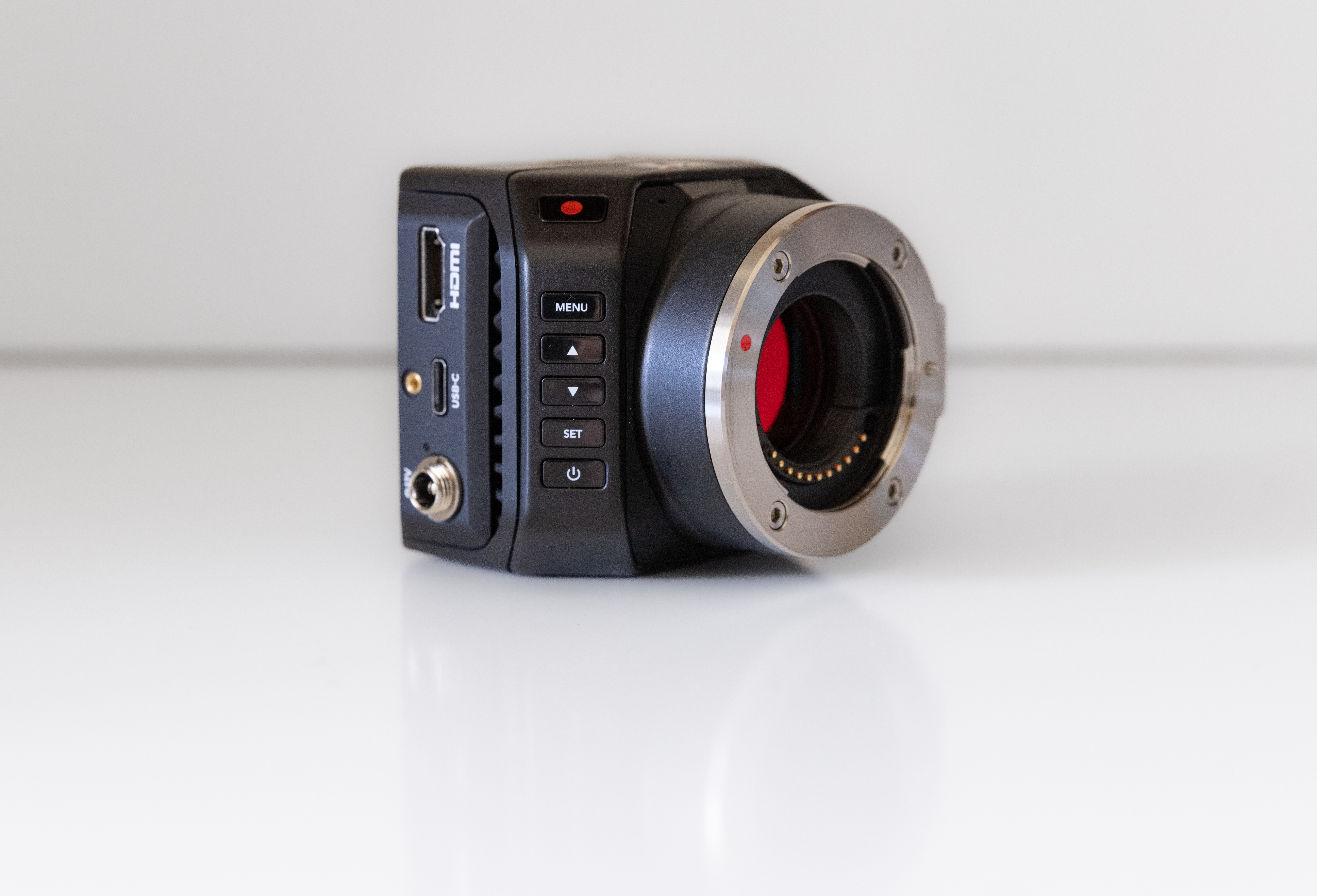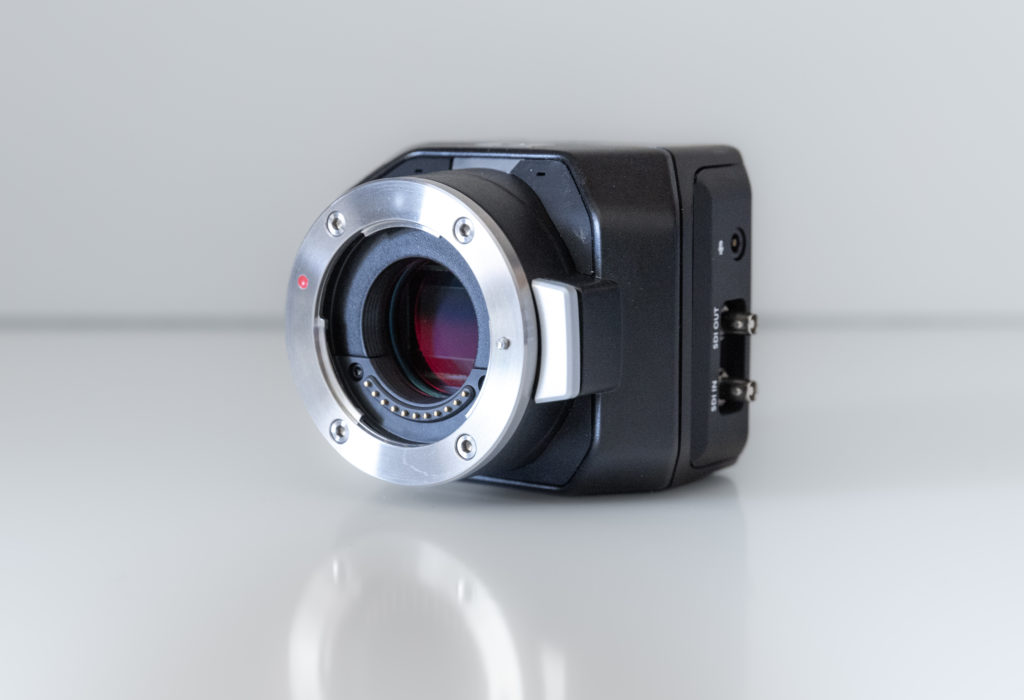What is great about Blackmagic Design is its ability to build cameras for a specific market niche. Let’s look at the Blackmagic Micro Studio 4K G2. I had the opportunity to test this camera for a couple of weeks. One of my big questions was how the sensor performed and whether the color was similar or identical to the Blackmagic Pocket Cinema Camera MFT cameras. As for the ability to remotely control the camera, I may not be the best one to take you down that path. I’m here for the image and it’s quality. 
I have written about Blackmagic since the original Blackmagic Cinema Camera 2.5K, and I’ve been impressed with their progress. Now, I am testing the Blackmagic Studio Camera 4K G2. This may be one of the smallest lens-changeable cameras on the market. The Blackmagic Micro Studio 4K G2 can be placed just about anywhere, a clever feature when shooting live productions.
It is a squirrelly-looking camera, small and fist-like, and not one’s traditional camera shape. The on-camera buttons are small for my extra-large hands and are not the most tactile to feel, nor are they easy to access if the camera is rigged up for shooting. But this camera yearns to be connected to an ATEM switcher and it really needs to be connected to an ATEM switcher to reach its potential.
The Micro 4/3-sized sensor is a bit odd this far into the digital cinema camera revolution. Still, I get the reason for Blackmagic’s continued use: to keep the Blackmagic Studio Camera 4K G2 small and use relatively inexpensive MFT lenses that can be controlled by one of Blackmagic’s switchers. This is a much-needed feature if one places the Blackmagic Micro Studio 4K G2 in a hard-to-reach area during a live production. You can’t have an operator standing next to the camera if the Blackmagic Micro Studio 4K G2 is mounted in an unusual spot.
I also suspect Blackmagic Design may be using the second-generation Blackmagic Pocket Cinema Camera MFT sensor in this new Blackmagic Micro Studio 4K G2 camera, which is perfectly fine as that sensor was of good quality. In my example video, I wanted to see how the color looked from the camera, and it appeared to have that quality that we’ve come to associate with Blackmagic, which is great color depth.
I found the RAW color and image from the Blackmagic Micro Studio 4K G2 to look good. The color had the kind of bit depth that one loves if you want to grade the image or create a specific LUT for a shoot. I could push and pull colors in a way that did not cause the image to fall apart in DaVinci Resolve. Recording any flavor of raw video with a camera this size is amazing.
I think using a created LUT for a camera the size of the Blackmagic Micro Studio 4K G2 is smart. The ability to import a LUT allows shows and productions to create a look they want that is unique to their style. One doesn’t usually find this feature in cameras this size. Color can be controlled remotely within a Blackmagic Switcher using that hardware’s internal DaVinci Resolve color capabilities. Again, the benefit of using the Blackmagic Micro Studio 4K G2 while connected to an ATEM Switcher.
What I shot on the Blackmagic Micro Studio 4K G2
I shot my example on vintage Minolta lenses as I have an MFT to Minolta MD adapter, making it easy to test to the Blackmagic Micro Studio 4K G2. The vintage nature of Minolta lenses took the sharpness off a bit in the image, which was fine with me for what I was shooting: a video of my daughter. When using MFT lenses, the image will be noticeably sharper than what I shot, what with modern lenses an all. Once I had the camera set to what I wanted: ISO/Gain, White Balance, LUT, and 60fps, I just got down to capturing the best video I could. Shooting this way was easy and the small size of the camera can be a huge advantage.
Dual-Native ISO
In the Blackmagic Micro Studio 4K G2, the ISO settings may be used to be shown as a gain setting, which is more along the lines of most live production cameras. The Blackmagic Micro Studio Camera features gain from -12dB (100 ISO) up to +36dB (25,600 ISO). The Blackmagic Micro Studio 4K G2 also keeps the dynamic range the same through the gain/ISO setting. The native ISO is 400, but since this sensor has a dual-native ISO, the secondary native ISO is 3200. The gain can be set from the camera HDMI menu, or remotely from a switcher using the SDI/HDMI remote camera control.
Optional Zoom and Focus
The optional zoom and focus made by Blackmagic Design can be added when you want to rig the Blackmagic Micro Studio Camera 4K as a bigger custom studio camera. Each zoom and focus demand has 2 USB-C ports, so you can daisy-chain them and connect them to the camera’s USB connection.
The only problem I find with the Blackmagic Micro Studio 4K G2 is the small size and design of the buttons. Some of that is me and what and how I shot my video. Without using a connected Blackmagic ATEM switcher, the Blackmagic Micro Studio 4K G2 is a little bit more than clunky to use. Accessing the menu via the on-camera buttons starts out frustrating but ends up in a place of slight annoyance to have to change anything.
Blackmagic Micro Studio 4K G2 Battery
The Blackmagic Micro Studio 4K G2 comes with a place for a Canon LP-E6 battery, which is a very common battery that can be found just about anywhere. But how long does the LP-E6 last? In my non-scientific study, the Blackmagic provide LP-E6 lasted between 30 and 45 minutes. That is not a long time for a battery to last on a camera. Yet, do not think about the LP-E6 battery as the main power source for the Blackmagic Micro Studio Camera 4K G2 and more as a means to have an emergency backup battery.
When the Blackmagic Micro Studio 4K G2 is plugged into a power source, that power source charges the LP-E6 as it powers the camera. I found this to be the best practical use of the battery option on a camera like the Micro Studio 4K G2. Plus, I doubt many live productions are going to rely on an LP-E6s as the dedicated power source for a camera like the Blackmagic Micro Studio 4K G2, which is also placed in a hard-to-reach spot.
SDI/HDMI
I love that the Micro Studio 4K G2 comes with an SDI mini in and an SDI mini out, but the camera also comes with an HDMI output. I have a love/hate relationship with HDMI. It seems to me that any HDMI output is the first thing to break on a camera, and it seems especially easy to break on the Blackmagic Micro Studio 4K G2. This is mainly because of the size of the camera and how easy it is for one’s hands to bump or stress the HDMI port. I understand the reason Blackmagic put both the SDI mini input/output and the HDMI, as it gives users more options for monitoring, and the SDI has a lot of features to use when combined with the ATEM Switcher.
Recording to an SSD
I chose to record onto a small external SSD for my shoot. I used a little 1TB Toshiba, and I strapped it to my camera in about the most unprofessional manner, but it worked. I’m still on the fence about recording to an external SSD. It seems that the cords and placement of an external SSD open up a whole lot of opportunities for something to go wrong or break. This apprehension comes from twenty years as a cameraman/dop, where I have seen just about every kind of malfunction and found a way to work past those malfunctions. With one single record function, you run into one malfunction, and you’re down a camera, but this is where having the whole Blackmagic ecosystem can save you. If you have one of Blackmagic’s great Video Assists, you can record it over SDI or HDMI with the Blackmagic Micro Studio 4K G2 camera.
I like to think that if you have one option, one cord, or whatever you need for a successful shoot, you are actually one malfunction from cutting your shoot short quickly. Two of something is better. Three or triple backups or options are where you may want to be if you want to be seen as a reliable shooter. What’s great about the Blackmagic Micro Studio 4K G2 is that it is so inexpensive, and I could see users have multiple in a pelican case.
Overall Thoughts
Ideally, the Blackmagic Micro Studio 4K G2 is meant to be connected to a whole suite of live production equipment to maximize its capabilities. In fact, I suggest using the Blackmagic Micro Studio 4K G2 only in a connected production environment, and you’ll feel the satisfaction of having a unique and useful camera in your arsenal.
Overall, the Blackmagic Micro Studio 4K G2 is a good camera with a good image and great connectivity to other Blackmagic Live Production equipment. The raw recording capabilities are a bonus, and the remote color control via ATEM switcher aligns the Blackmagic Micro Studio 4K G2 into a place that fits very well in the Blackmagic ecosystem.
Blackmagic Micro Studio Camera 4K G2 Key Features
- Active Micro Four Thirds Lens Mount
- UHD 4K Resolutions up to 3840 x 2160p60
- 12G-SDI Video Input/Output, HDMI Output
- 13-Stop Dynamic Range, Compact Design
- Camera Control via SDI, HDMI, or USB
- Program and Talkback over SDI, Tally
- USB-C Expansion Port, 3.5mm Audio In
- Built-In Color Corrector
- Canon LP-E6 Battery Slot

